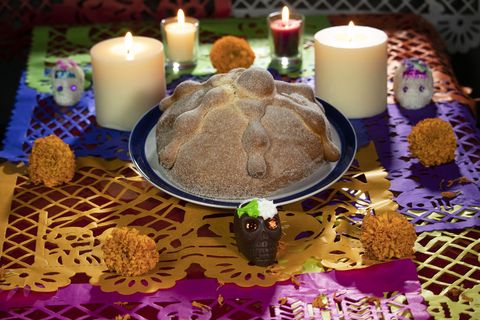Day of the Dead, also known as Dia de Muertos in Spanish, is a Mexican holiday where beloved family members that have passed away get to visit the land of the living and reunite with loved ones. Although it may be perceived as a somber holiday, it’s actually a grand celebration with music, food and vibrant decorations. Each year, families set up ofrendas (an altar with offerings) with their family members’ photos, Day of the Dead flowers, favorite foods and most cherished personal items to welcome them back during Día de Muertos. Although it’s widely celebrated in Mexico, this holiday has become more popular over the years, even in the United States! So, if you are wondering when Day of the Dead is this year so you can mark your calendars, we are sharing everything you need to know, including tons of interesting Day of the Dead facts!
When is Day of the Dead?
Although families prepare days in advance, Day of the Dead is celebrated during November 1 and November 2. The first day is dedicated to children who passed away and is called Día de los Angelitos. Families often create an ofrenda that is adorned with the child’s favorite candies, toys and their photos. The following day is called Día de los Difuntos which is for the adults. They also have an altar that is decorated, often with pan de muerto (bread of the dead), tequila, other favorite items and of course, their photos.
History of Day of the Dead
This holiday dates back 3,000 years, deriving from pre-Columbian Mesoamerica from the Aztecs and Nahual people. Originally, this celebration was a festival during the summer months that was dedicated to Mictecacihuatl, known as “lady of the dead, who guards the bones of the deceased in the underworld with her husband Miclantecuhtl. However, once the Spaniards arrived in the 16th century, this Indigenous festival was later moved to November 1 and November 2 to correspond with the Catholic calendar which celebrates All Souls’ Day and All Saints’ Day.
Who celebrates Day of the Dead?
Day of the Dead is primarily celebrated in modern day Mexico, however, other Latin American and Catholic countries, as well as the United States, have taken part in these festivities as well.
Is Day of the Dead the same as Halloween?
Although the Day of the Dead and Halloween are held close together on the calendar, it’s important to note that these two celebrations are very different. While the history of Halloween dates back to Celtic traditions and includes modern festivities with scary costumes, trick-or-treating and everything spooky, the Day of the Dead commemorates a joyous celebration for families to reunite between the living world and the afterlife.
Day of the Dead Traditions
While there are several ways to celebrate Día de Muertos depending on the region, some of the most common traditions include placing a loved one’s photo on the ofrenda, as well as pan de muerto, sugar skulls and marigold flowers.
Pan de muerto
This sugar-coated bread is made to place on the ofrenda to nourish the souls of spirits after their journey to the living word. Although pan de muerto varies by region, it’s often baked with orange zest or anise and has bones formed from dough on top.
Calaveras
Calaveras (skulls) can be seen throughout this celebration. One of the more popular calaveras that you’ll see during Día de Muertos is the sugar skull which typically represents the person who had passed. You can find calaveras with the person’s name written on the forehead, as well as other colorful décor.
Flor de cempasúchil (Marigold flowers)
These vibrant orange and yellow flowers are meant to attract souls to their altars with their prominent fragrance. Marigolds are one of the more popular flowers that you will see during Día de Muertos, often seen on crosses, ofrendas and displays.
Ofrenda (altar)
An ofrenda is where everything comes together! Families prepare the altar with loved ones’ photos, marigolds, candles, tequila, wine, pan de muerto, calaveras and personal items that identified the person. It’s common to see an altar with two levels, the top level with the person’s photograph and personal belonging, while the bottom half includes offerings like food and water to nourish their souls after a long journey.
Whether you have grown up celebrating Día de Muertos or are new to this beautiful tradition, there is always something new to learn about this holiday and a way to take part in the festivities. Perhaps you can bake pan de muerto, create marigold flowers out of tissue paper or make calaveras to honor past relatives during this special time.
This content is created and maintained by a third party, and imported onto this page to help users provide their email addresses. You may be able to find more information about this and similar content at piano.io




